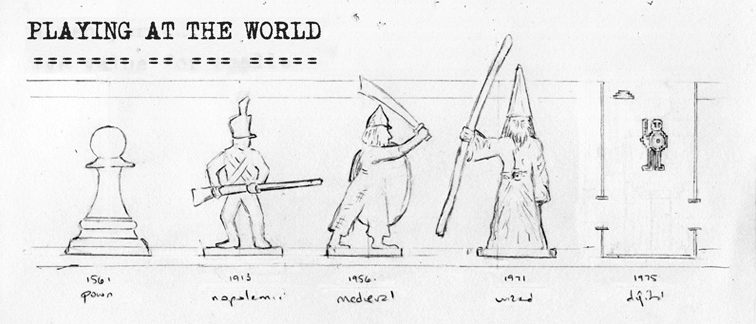Dungeons & Dragons is back in the news, what with it being 40 years old (Happy Birthday, D&D!) and the release of the new Starter Set. Hopefully this means lots and lots of new players and new fans. There’s a lot of history when it comes to D&D, however, and anyone discovering it for the first time might also be interested in this history.
George Santayana (December 16, 1863 – September 26, 1952), a poet and novelist among other things, famously said “Those who fail to learn the lessons of history are doomed to repeat them.” Yeah, that doesn’t really apply here. Well, unless you’re a Dungeon Master (DM) that hasn’t figured out that it’s a bit cliche to start your players’ new adventure off with You’ve all gathered at the Griffin’s Tail Tavern…
Don’t be that DM.
Anyway, I guess what I’m getting at is there’s so much great history related to our favorite RPG. I’ve always been fascinated with behind-the-scenes stories, and D&D certainly has its share. One of the more recent is a detailed account by Jon Peterson of how Ernest Gary Gygax was ousted from TSR, Inc. in 1985. It’s titled “The Ambush at Sheridan Springs: How Gary Gygax Lost Control of D&D,” and it’s required reading by anyone calling himself or herself a Dungeons & Dragons fan. Many of us see D&D as a game, but we forget that there was a company, filled with employees (over 300 at one point), that answered to a board of directors. And as anyone who has ever worked in an office setting knows, there’s office politics in every business. And TSR wasn’t immune.
If you’re looking for even more history, you may recognize Peterson as the author of Playing at the World, considered by many to be the definitive history book on wargaming and the development of D&D. This 700-page book has a special spot on my shelf right next to my original Advanced Dungeons & Dragons Dungeon Master Guide. If only all college history textbooks were this entertaining…
Two other books I also recommend for the D&D history buffs include David M. Ewalt’s Of Dice and Men: The Story of Dungeons & Dragons and The People Who Played It (currently in hardback but available in paperback September 2014 — my original review here) and Brad King and John Borland’s Dungeons & Dreamers: A Story of How Computer Games Created a Gaming Community (my original review here). The first book is a more personal story mixed with some history of not just D&D but wargaming, LARPing, and a few other subjects. The second book discusses the inspiration D&D provided to many of the up-and-coming computer game developers.
Finally, I’m going to return to Jon Peterson and recommend his blog that continues to provide background stories, interesting facts, videos, and much more about D&D (and do NOT forget to reads the comments as they often contains some gems). It’s one of those websites that I’ve pinned to my favorites and check in on often. Peterson always manages to find the best stuff to share with his readers, so please encourage him to continue if you like what you read there.
As we fans celebrate the release of the new rules, let’s not forget where D&D came from and everything that’s happened in between 1974 and 2014. As with any subject with a long history, there are dark periods. Fortunately they tend to be overshadowed by the good times. And D&D is (and always will be) all about the good times.







A comment on Jon Peterson’s article about Gary Gygax’s last days at TSR contained a link to an interview I read sometime back and then lost. I won’t do that again. Here’s an outstanding interview with GG if you’ve never read it… set aside some time… it’s length.
http://www.thekyngdoms.com/interviews/garygygax.php
Well, unless you’re a Dungeon Master (DM) that hasn’t figured out that it’s a bit cliche to start your players’ new adventure off with You’ve all gathered at the Griffin’s Tail Tavern…
Don’t be that DM.
Why not? Some of the best DM’s I have had the honor of playing with avoided focusing on minutia and directed their labors toward the adventure… game sessions, especially those with larger than average groups of players and adult players where time is often at a premium, are better served when interest stays high. That means getting to the meat as soon as possible.. if a white owl showing up with a letter is the most expedient method of doing so then I say send the owls.
Point being each group is different and a good DM adapts as required.
Absolutely! But that still doesn’t mean the tavern isn’t a cliche. Some of the best games I’ve played were with DMs who threw the party right into a fight or crime or even prison in one very memorable escape adventure.